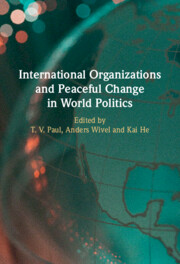Book contents
- International Organizations and Peaceful Change in World Politics
- International Organizations and Peaceful Change in World Politics
- Copyright page
- Contents
- Figures
- Tables
- Contributors
- Acknowledgments
- Part I Introduction
- Part II Theory
- Part III Practice
- Part IV Conclusions
- 13 The Science of Peaceful Change
- 14 International Organizations and Peaceful Change
- Index
13 - The Science of Peaceful Change
from Part IV - Conclusions
Published online by Cambridge University Press: 30 January 2025
- International Organizations and Peaceful Change in World Politics
- International Organizations and Peaceful Change in World Politics
- Copyright page
- Contents
- Figures
- Tables
- Contributors
- Acknowledgments
- Part I Introduction
- Part II Theory
- Part III Practice
- Part IV Conclusions
- 13 The Science of Peaceful Change
- 14 International Organizations and Peaceful Change
- Index
Summary
This chapter looks at the assumption that there is a relationship in world politics between international organization and peaceful change. That premise is the working hypothesis behind many of the chapters in this book, and it provides the justification for the scholarly search for empirical patterns between IOs and change. When international relations is assumed to be comprised of a mechanical ontology (causal mechanisms that lead from initial conditions to predictable effects), then it makes sense to employ a scientific methodology indebted to Isaac Newton. But the shifty concepts of world politics, such as conflict, peace, change, and stability, are not well-suited to machine-like regularity. Concepts such as change are subjective or ambiguous and hence make for poor variables. The chapter examines the gap between methodology and ontology that emerges in the effort to find causal mechanisms that link the practice of international organization to the outcomes of peaceful change.
- Type
- Chapter
- Information
- Publisher: Cambridge University PressPrint publication year: 2025

